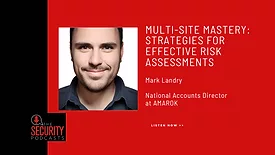Security Enterprise Services
Multi-Site Mastery: Strategies for Effective Risk Assessments
Listen to Mark Landry, National Accounts Director at AMAROK, in this podcast episode.
October 24, 2024
Proving physical security value across an organization
Listen to Thomasina Martin, a Key Account Manager specializing in Energy and Utilities at Genetec, Inc., in this podcast episode.
October 16, 2024
Security Talk
Learning from leaders across sectors
The monthly Solutions by Sector live webinar series highlights enterprise security best practices across a number of industries.
October 14, 2024
Balancing Risk and Innovation - A CISO Perspective
Listen to Jill Knesek, CISO of Blackline, in this podcast episode.
September 25, 2024
Sign-up to receive top management & result-driven techniques in the industry.
Join over 20,000+ industry leaders who receive our premium content.
SIGN UP TODAY!Copyright ©2025. All Rights Reserved BNP Media.
Design, CMS, Hosting & Web Development :: ePublishing
















